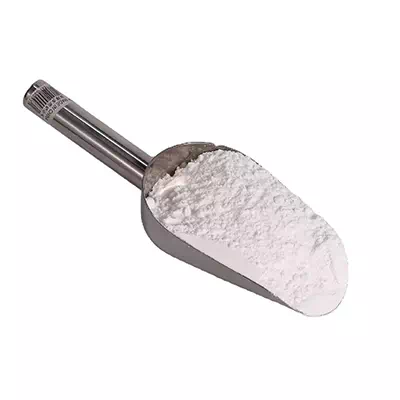

CAS number:56329-42-1
molecular formula:C5H11NO6S2Zn
molecular weight:310.66
EINECS number:260-113-8
Hydrogen (L-methioninato-N,O,S)(sulphato(2-)-O)zincate(1-);hydrogen (CL-methioninato-N,O,S)[sulphato(2-)-O]zincate(1-);ZINC METHIONINE;Zinc methionine bisulfate;OPTIZINC;OPTIZINC(TM);ZINC METHIONINE SULFATE;ZINC MONOMETHIONINE
Food and Feed Additives; Nutritional Additives; Food Additives; Inorganic Salts (Minerals); Nutritional Enhancers (Nutrition Supplements; Feed Additives; Agricultural and Veterinary Raw Materials; ; pharmaceutical raw materials; fine chemical raw materials; chemical reagents; organic chemical raw materials; raw materials and intermediates; daily chemicals; raw materials for veterinary drugs
Zinc is one of the essential trace elements for animal body, and it is a component of various metalloenzymes and insulin. It is called "life element" because of its wide range of physiological and biochemical functions in the body.
Zinc is a component of a variety of enzymes in livestock and poultry. It plays an important role in the normal growth and development of livestock and poultry fur and bones, reproductive function, the development of the taste system and the normal function of the cardiovascular system. Essential for skin health and tissue repair. Zinc can also affect the synthesis of DNA and RNA, and participate in the metabolism of nucleic acids and proteins. When zinc is deficient, animals suffer from incomplete skin keratosis, loss of appetite, incomplete embryonic development, decreased reproductive function, growth arrest and abnormal metabolism of epithelial cells, and lead to low immune function of livestock and poultry, increased susceptibility to disease, affecting Growth and development and feed utilization of livestock and poultry.
In traditional feeding, zinc in animal diets is provided in the form of inorganic salts. In recent years, the application of organic zinc and chelated zinc has become more and more widely used. Zinc methionine is the zinc salt of methionine, which is chelated by methionine and zinc. , is a new type of feed additive, which can be used as a supplement of trace element zinc in animals. Many reports have confirmed that the addition of zinc methionine can improve animal growth, reproduction and health, and can promote the rapid proliferation of taste bud cells in the tongue mucosa, regulate appetite, inhibit some harmful bacteria in the intestine, prolong the residence time of food in the digestive tract, and improve the secretion of the digestive system. function and the activity of enzymes in tissue cells. The absorption rate of zinc methionine in animals is 2-4 times that of ordinary inorganic zinc, and methionine itself is also a high-level nutrient. Humans and animals can absorb zinc at the same time as methionine.
| Storage conditions | Inert atmosphere,Room Temperature |
| CAS database | 56329-42-1(CAS DataBase Reference) |
White flowable powder, good flowability, uniform without agglomeration, with the special smell of methionine. Insoluble in water and ethanol, soluble in dilute acid and dilute alkali, the divalent zinc cation forms a coordination bond with the oxygen of the amino acid whose carbonyl group is yet to be negatively charged and the electron donor amino group, and multiple ligands can satisfy the zinc ion at the same time. Coordination number and valence, the formation of coordination bonds is that the compound forms one or two five-membered rings. The tension between each bond in the five-membered ring structure is the smallest among cyclic compounds, so it has good chemical stability and biochemical properties. stability.
● Nutritional fortifier (zinc source). Usually made into tablets.
● Used as nutritional additive, can be used in food, feed, medicine and other industries
● Nutritional additives, can be widely used in feed and food industry.
● Effects on chickens: Under intensive production conditions, organic zinc can improve the immune function of chickens. The 120-day-old turkeys fed with zinc methionine and manganese methionine have improved feed conversion rate, mortality rate, and foot deformity rate. improved. The 45-day-old broilers also fed zinc methionine and manganese methionine also had significant improvements in feed conversion ratio, breast meat mass, bone ash content, and skin lesions.
● Effects on pigs: The nutritional effects of zinc on pigs mainly include the following aspects: the effect on the synthesis and activity of enzymes in pigs; the relationship with pigs' appetite, nutrient digestion, material metabolism and growth; Effects on reproduction and immunity. According to research, zinc methionine has different degrees of improvement on the above aspects. The addition of zinc methionine to the diet of finishing pigs increased the average daily gain by 9.7%, the feed utilization rate by 3.3%, and the slaughter rate and lean meat rate were improved.
● Effects on rabbits: The addition of zinc methionine to the meat rabbit diet has obvious weight gain effect. Methionine chelated zinc has good chemical and biological stability due to the coexistence of ionic bonds and coordination bonds in its chemical structure. In the pH environment of the body, it has good solubility and is easy to release zinc ions, so it is easily absorbed by the body. The absorption speed is 2 to 3 times faster than that of inorganic zinc, and the biological effect is also higher than that of inorganic salts. After feeding zinc methionine, it meets the body's demand for zinc, and methionine is also absorbed when the body absorbs zinc, so it can promote the growth and development of meat rabbits. The test thinks that the dosage of 50 mg per kilogram is more suitable. It is also reported that zinc is an essential element to maintain the optimal activity of mononuclear phagocytes (MNPs), which can phagocytose pathogens. Therefore, zinc can affect the indirect cellular defense system of meat rabbits, improve the immune function of rabbits, and prevent diseases. effect.
● It is obtained by the reaction of equal concentrations (mol/L) of zinc sulfate and DL-methionine in pure water.
● A preparation method of zinc methionine, comprising the following steps:
(1) salt-forming reaction step: drop in successively 100 moles of methionine, 1500 moles of water, 55 moles of zinc oxide, 2 moles of formic acid in a 100-liter reactor with heating device, electric stirring, and thermometer, and simultaneously heat 70 moles under stirring for 70 minutes. -80 ℃ reaction, under stirring for 6 hours, stop heating, the salt-forming reaction is completed.
(2) drying step: the granular product obtained by centrifugal separation is placed in a stainless steel drying sieve with ventilation at the top and bottom, and is placed in a drying oven for drying; after 24 hours, the obtained product is sieved to obtain a finished product of zinc methionine , the zinc methionine product contains more than 15% zinc.
Sales hotline:

 Scan and consult wechat customer service
Scan and consult wechat customer service